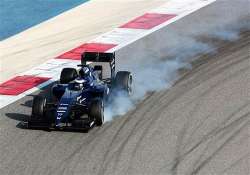F1's new rules leaves cars quieter, slower.
Madrid: Formula One's latest changes mean the sexy purr of engines and the violent throttle of speed won't quite be what they used to be.The usual title talk has surrounded preseason testing as usual, but

Madrid: Formula One's latest changes mean the sexy purr of engines and the violent throttle of speed won't quite be what they used to be.
The usual title talk has surrounded preseason testing as usual, but the normally boisterous roar of F1's engines has been slightly subdued.Get used to it.
"I've grown up with the `old' sound, and I loved it. Some of the old cars that had the exhaust coming under the floor, the sound was just awesome just from the TV," Mercedes driver Lewis Hamilton said. "The V10 and V8 of the last few years, with their special roar, had goose-bumps potential. When you started the engine you had to cover your ears. That's history. F1 is moving on."
In a bid to bolster innovation and perhaps shake up Red Bull's grip at the top of the standings, F1 has cast out the 2.4-liter V8 engines to make way for 1.6-liter V6 turbo engines, which means a drop of traditional horsepower.
The loss is expected to be made up by the Energy Recovery Systems, which generates energy under braking by using wasted heat from the engine's turbocharger. It is expected to give drivers double the amount of kick for five times as long.
"It is a step back F1 is slower than last year," four-time defending champion Sebastian Vettel of Red Bull said during preseason testing. "But how much slower, we will see once we get the car in a condition where we can start to look for speed."
Red Bull has yet to reach that point as it ended testing with Renault unable to provide its teams with an engine configured to excel under the new rules.
And whether the new racing will be what fans want will be seen over the course of a 19-race season, starting with the Australian Grand Prix on March 16.
"We are not in race conditions here, but if we were in race conditions I think I should bring a GP2 car," Japanese driver Kamui Kobayashi said of his Caterham car, which was also never expected to be one of the fastest cars on track.
"The lap time is still quicker in GP2. We need to work, but in this moment if we were to race, I think it's not Formula One."
Still, Ferrari driver Fernando Alonso said the new cars are easier to maneuver, with less force and speed on the corners even though there are more parameters to control, "more buttons on the steering wheel."
"I've driven karts that are half a minute slower than F1 and I still sweated and enjoyed driving. As long as you are driving at the limit, the lap time you do, it doesn't change the emotional point of view. This car is still fun to drive."
Drivers were encouraged that the pace would pick up as the season progressed, even as many struggled in testing as teams grapple with the new mechanics.
Hamilton, the 2008 champion who is a favorite to depose Vettel from the top, was choosing to embrace change.
"Maybe we will soon all be happy about this new `low noise.' It sure will make communications between cockpit and pit wall easier," the British driver said. "There are always good and bad things attached to the same medal."